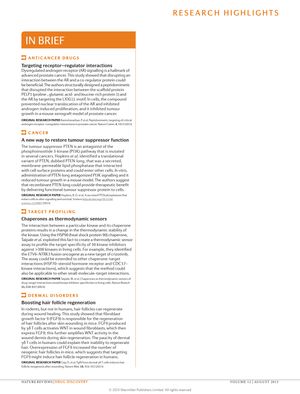Chaperones as Thermodynamic Sensors
August 2013
in “
Nature Reviews Drug Discovery
”

TLDR New cancer treatments show promise in reducing tumor growth and improving skin regeneration in mice.
The document summarizes several studies on cancer drugs, tumor suppressor function, target profiling, and dermal disorders from 2013. One study identified a peptidomimetic that disrupts the interaction between the androgen receptor (AR) and the co-regulator protein PELP1, inhibiting AR nuclear translocation and androgen-induced proliferation, and reducing tumor growth in a mouse model of prostate cancer. Another study introduced PTEN-long, a secreted variant of the tumor suppressor PTEN, which can enter cells, antagonize PI3K signaling, and reduce tumor growth in mice, suggesting potential therapeutic benefits. A third study used a thermodynamic sensor assay to profile the specificity of 30 kinase inhibitors against over 300 kinases in living cells, identifying the ETV6-NTRK3 fusion oncogene as a new target of crizotinib. Lastly, a study on dermal disorders found that fibroblast growth factor 9 (FGF9) is key for hair follicle regeneration after skin wounding in mice, and its overexpression increased neogenic hair follicles, indicating that FGF9 might be targeted to induce hair follicle regeneration in humans.




